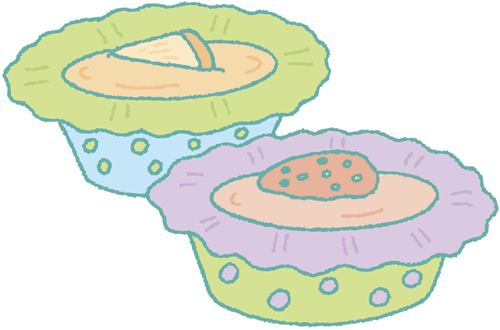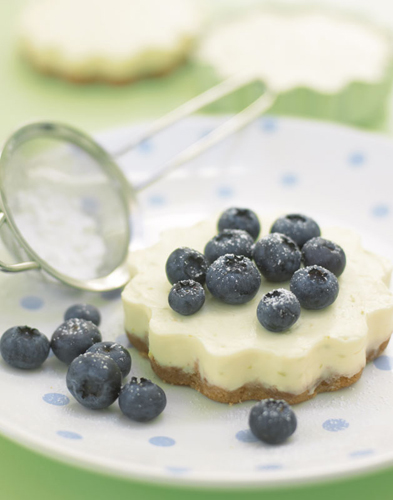|
Some little ones seem to be born with a sweet tooth, no matter how scrupulously savory their weaning menu has been! Sweets and treats do have a place in your toddler’s healthy, balanced diet, but it’s important to get the balance right.

| Q: |
My toddler has a sweet tooth. How can I satisfy her with healthier alternatives?
| | A: |
Many toddlers instinctively prefer sweet foods to savory
alternatives, and if they become used to foods that contain added sugar,
they’ll find the natural sweetness of healthy options, such as fruit,
bland and boring.
If you have added sugar
to your toddler’s food in the past, cut down rather than remove it
completely. If she’s used to sweetness, she may resist anything without
sugar. Try sweetening your child’s food with fruit juice or fruit purée
instead. While this is still sugar in another form, it is healthier
because unlike refined sugar it contains vitamins and minerals.
Similarly, maple syrup, molasses, and honey offer nutrients while they
sweeten, making them a much healthier option. Work toward providing
plenty of fresh, natural foods that are sweet in their own right, and
present less risk of tooth decay and health problems.
|
| Q: |
My toddler seems to be quite hyperactive after eating anything sweet. What can I offer instead?
| | A: |
Many children are sensitive to sugar, and get a burst of
uncontrollable energy after eating anything sweet, particularly if it
contains refined white sugar. The down side is that soon after they have
eaten it, they “crash” as their blood sugar levels fall, and can become
tearful, tired, and grumpy. However, sweet does not necessarily mean
unhealthy. Fresh fruit is high in naturally occurring sugars, but
because of the fiber content of the fruit, it tends to be digested more
slowly than other sugary foods, which prevents that surge of wild
energy. Similarly, dried fruit is sweet, but also healthy.
Adding a
little protein alongside (a yogurt dip for fruit, for example, or a few
chunks of cheese, or even a little ham) can slow down the transit of
sweeter foods, and prevent the hyperactive effect. Try to get your
toddler used to eating a better balance of savory and sweet. Healthy
never has to mean boring, and if you keep on presenting some interesting
and delicious meals, your toddler will quickly forget all about the
sweets that were once a bigger part of his diet.
|
| Q: |
Are there any sweets that are appropriate for this age group?
| | A: |
Children under the age of two don’t need sweets as such, and they
are unlikely to object to not being given them. That doesn’t mean that
they can’t have sweet “treats” from time to time, such as delicious
fruit tarts or puddings (see Blueberry-lime cheesecakes), or even fresh fruit popsicles
and fruit spreads. The longer you can resist giving in to packaged
sweets, the better the chance that your toddler will develop good eating
habits, and a healthy diet. One exception is a little good-quality
chocolate (if your child likes it). It may do nothing for your child’s
teeth, but it does have some health benefits that most other sweets do
not.
|
| Q: |
Are there any “healthy” foods that might damage my toddler’s teeth?
| | A: |
Many healthy foods contain high levels of natural sugar, such as
lactose (in milk) and fructose (in fruit). Milk, fruit juice, fruit, and
dried fruit can all cause problems with teeth if they are consumed
between meals. Dried fruit in particular is quite sticky, and can stay
on the teeth for longer periods of time, creating the conditions that
cause decay, and fruit juice can be very damaging. For this reason, it’s
a good idea to offer these foods with meals, rather than as snacks, and
offer a cube of cheese or a few spoonfuls of yogurt alongside, as these
serve to neutralize the acid that can lead to problems. Offer sweet
snacks such as raisins in a short time space, thereby limiting the
damage they might cause if your child spends the afternoon grazing on
them. If your toddler is still on a night-time bottle, don’t allow him
to go to bed with it.
|
| Q: |
Should I brush my toddler’s teeth after sweet snacks?
| | A: |
Interestingly, it’s not a good idea to brush teeth immediately
after sweet snacks, as the acid they contain damages the enamel, and
brushing immediately can cause bits of enamel to be brushed away.
Dentists recommend waiting at least an hour before brushing teeth after
eating. This allows your toddler’s saliva to get to work. Saliva is
saturated with calcium and phosphate, which promotes the
remineralization of teeth. It also neutralizes the acids produced by
bacteria and acts as a reservoir for fluoride, which also works to
ensure that teeth are remineralized, and bacterial acid is inhibited. It
is, however, a good idea to give your little one some water to “rinse”
her mouth after eating.
|
Ditch the fizz
A typical 12fl oz
(330ml) can of soda contains about 5 teaspoons of sugar. Diet drinks
aren’t much better because, like most sodas, they contain acids that
have been linked to drawing the calcium from our bones. The acids in
fruit juices and smoothies are also bad for children’s teeth. It’s best
to give fruit juice and smoothies at mealtimes and only give water
between meals.
Blueberry-lime Cheesecakes
This dessert is ideal for little ones since it makes small, individual cheesecakes. They are fun to make with your child—he can help crush the crackers, mix the filling, and put the fruit on top. A gingersnap base and raspberries are nice alternatives.

15 minutes
3oz graham crackers, or 1 cup unpacked crumbs 3 tbsp butter, melted 1/4 cup cream cheese, at room temperature 1/4 cup thick (Greek-style) plain yogurt Grated zest and juice of 1 lime 1/4 cup powdered sugar, sifted 1/2 cup heavy cream For serving1/2–1 cup blueberries Powdered sugar
Put the graham crackers in a
heavy-duty plastic bag and crush to fine crumbs with a rolling pin.
Stir the crumbs into the melted butter. Divide among four 3in-diameter
loose-bottomed tart molds. Press the crumbs evenly over the bottom.
Put the cream cheese in a
bowl and beat to soften slightly. Add the yogurt, lime zest and juice,
and sugar and beat to combine. Whip the cream in a separate bowl until
it makes soft peaks, then fold into the cream-cheese mixture.
Spoon the filling into
the molds over the crumb bases. Cover and chill for at least 2 hours, or
overnight, to set. Or freeze the cheesecakes; when needed, thaw
overnight in the refrigerator.
Remove the side from
each mold, then use a metal spatula to carefully lift the cheesecake
from the bottom of the mold and place on a plate. Top each cheesecake
with blueberries and dust with sifted powdered sugar before serving.
|